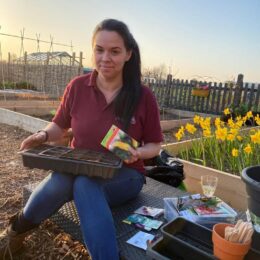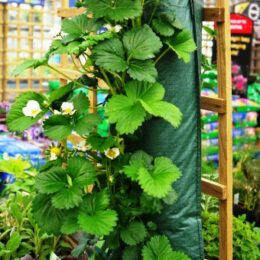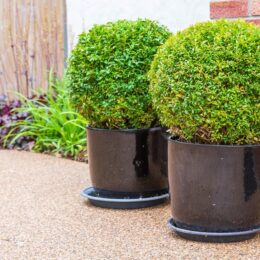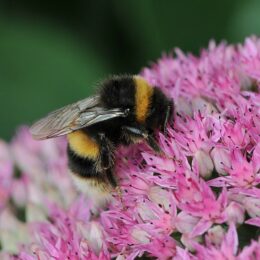Want to grow your own vegetables from seeds but are not sure where to start? We have some great tips below for growing radishes, carrots, aubergines, sweetcorn, onions, runner beans, and potatoes. You can grow your vegetables in your allotment, a veg trug, or containers depending on the size. Picking your own fresh vegetables from the garden will create a sense of achievement and if you have space, you can grow as many varieties as you’d like.

GAP Photos Ltd
Radishes

Radishes are perfect for salads as they’re crunchy and can have a peppery taste. They can be extremely easy to grow from seed in a window box or your allotment.
- Buy radish seeds (we have lots of different varieties in-store).
- Sow half an inch deep and don’t sow the whole packet all at once. Save some to sow in 2 week intervals to ensure you have radishes throughout the summer. There is not much that can be done with a glut of radishes apart from giving them away!
- Aim for one seed every inch or so, or don’t worry too much and thin them out by hand once they shoot through. If they are too bunched up you will get some very strange looking radish!
- Keep the soil nice and moist, as if they dry out the radish could split and won’t be so tasty
- Watch out for slugs and snails eating the seedlings. Use slug pellets, natural slug killers, or try putting crushed eggshell barriers around the plants to deter them
- Your radish should be ready to eat four weeks after sowing, eat freshly picked and enjoy. Slice up and add to a green salad – delicious with salad cream!
Carrots

Carrots are easy to grow, and with successional sowing, they can be enjoyed all year round! If you’re short of space, carrots can be grown in containers, you just need to ensure the container is deep enough for the variety you are growing.
Carrots are classified according to when they mature:
Earlies are relatively quick to grow (approx. 7 to 9 weeks). They are smaller in size and are eaten immediately after harvesting.
- Nantes 2 – ideal for early sowing, rich orange colour and sweet crunchy taste
- Flyaway – excellent resistance to carrot fly. Naturally sweet tasting (We also sell these as young plants ready to be planted)
Maincrops take longer to grow (approx. 10 to 11 weeks) and are generally bigger. They can be eaten fresh from harvest or stored and frozen.
- Autumn King – can be harvested from late summer or left in the ground throughout winter
Position – Open, sunny but sheltered site. Carrots will also grow in containers (such as a free-standing VegTrug) or growbags if positioned correctly and with adequate drainage.
Soil – Fertile and well-drained (avoid stony, compacted or damp soil)
Preparation – Work some lightweight organic matter into your soil (preferably in the autumn so this has time to break down and improve the soil structure over the winter months). When you are ready to sow, rake the soil to a fine tilth.
TOP TIP: To help cut down on the weeding later on, you can always prepare the soil then leave it for a few weeks to allow weed seed to germinate and then hoe them off on a dry sunny day.
Sowing – Early varieties can be sown March – April, some varieties such as ‘Nantes 2’ can be sown in February under a cloche. The maincrop can be sown from April – June. Create small drills in the soil. Sow the seed 1-2 cm deep in rows, 15-30 cm apart. To ensure the seed is sown thinly you can combine it with sand or vermiculite. The less thinning out required the better as crushing any foliage can attract carrot fly. Carrot fly will fly low to the ground, so a good way of protecting your crop is to build a 90cm high barrier of very fine mesh around where you have sown.
Cultivation – When large enough to handle, thin the plants to 5-7cm apart.
TOP TIP: Thinning carrots is best done after watering in the evening to prevent the smell of leaves from attracting carrot fly. You could also try growing spring onions and leeks between your rows of carrots, the smell of these crops will deter them as well!
Care – Hand weed between rows, being careful not to crush any foliage. Water every two weeks and prevent the crop from drying out and then flooding, as this can cause the carrots to split.
Harvest – Earlies can be harvested from June to August. Maincrops can be lifted and stored in layers of peat or sand in October and November.
Aubergines

If you thought it wasn’t possible to grow aubergines in our British climate, think again! At Perrywood we sell a particular early cropping variety called ‘Moneymaker’, which is more tolerant of colder temperatures. Moneymaker produces good crop yields and can be grown in a greenhouse or in patio containers outdoors. We have young plants here ready to be potted up in your chosen location.
If you prefer to grow aubergine from seed, follow these simple steps:
Position – On the whole, aubergines prefer to be grown in a greenhouse. Sow aubergine seeds indoors from February to May.
Sowing – Soak seeds in warm water for 24 hours before sowing to assist germination. Sow seeds an inch deep into 9cm pots containing good quality seed compost. Place in a warm sunny position indoors and water. Once the seeds have germinated and the pot is filled with roots, transfer plants to 23cm pots of compost and return to a warm sunny position, continue to transplant into bigger containers as the plants fill the pots. Stake and tie plants as they grow.
Outdoors – If growing outdoors, ensure all risks of frost have passed. Choose a sheltered position in full sun and plant in rich fertile soil allowing 90cm of space between plants. Control weeds by hoeing or hand weeding between plants and rows. Keep the soil moist.
Care – Pick off the tip from the main stem when the plants are about 30cm high to encourage the plant to bush out. Water regularly and feed with a high potassium liquid fertiliser every two weeks to encourage healthy fruits. Mist the foliage regularly to discourage pests. When five or so fruits have set, remove the remaining flowers.
Harvest – Pick the aubergines once they reach approximately 15cm
Enjoy your aubergine as a ‘Melanzane alla Parmigiana’ prepared with layers of aubergine, parmesan, tomatoes and basil – just like mama makes!
Sweetcorn

Grow your own sweetcorn from seed so you can enjoy your home grown produce. The supersweet sweetcorn variety ‘Swift’ should produce a high yield and early crop, and are perfect for growing in our unpredictable British weather! Read on to find out how you can do it too.
Here’s our guide to growing your own sweetcorn from seed:
Sowing – Sow 1cm (1/2”) deep in 7.5cm (3”) pots or modular seed trays using free draining compost. Keep indoors on a sunny windowsill in a propagator or polythene bag until after germination.
Preparation – Soil should be well-prepared with organic matter, such as manure, in a sheltered sunny position.
Growing – After the risk of frosts has passed plant out in blocks 45cm (18”) apart.
Care – Once cobs start to form water well and add fresh compost around the base of each plant. Stake plants individually if they are tall or the location is exposed.
Harvest – August-September. The cobs are ripe when the silks (tassels) turn brown and when the liquid of the grains is thin and creamy. For best results eat them as soon as possible after harvesting.
TOP TIP: Tap the tops of the plants when the male flowers (tassels) open to help pollination; poor pollination results in sparsely filled cobs.
If you prefer to buy plants rather than grow from seed we have a very popular variety called ‘Earlibird’. It produces large cobs with wonderfully sweet and tender flesh.
Onions

Why not have a go at growing your own at home? Onions are a versatile crop, they are easy to grow and tend to be frost tolerant so a late sown crop can easily overwinter.
Onions can be raised from sets (especially raised small onions) or from seeds. Those from sets will mature before those from seed and tend to be more resistant to mildew and onion fly. Growing from seed is a good economical option and there tends to be more choice available.
At Perrywood we have a wide range of onion seeds available, including ‘Ailsa Craig’. This variety is a good choice for the show bench, but equally impressive in the kitchen with its lovely mild flavour.
Here’s our simple guide for growing onions from seed:
Position – Open, sunny site with well-drained fertile soil
Preparation – Dig the soil in advance of sowing and incorporate plenty of well-rotten organic matter (preferably in the autumn), then in the spring, just before sowing, rake the soil to a fine tilth
Sowing – Direct sow in spring at a depth of 1cm and a distance of 30m between rows. Once germinated, thin the seedlings to 4cm apart. Onions will take around 12 to 18 weeks to mature. It is possible to sow onions in late summer or early autumn, they overwinter and take up to 48 weeks to mature
Care – Regular hand weeding or hoeing is important because onions do not like competition! Make sure the onions are kept watered but don’t overwater as this can lead to downy mildew
Harvest: Late summer
TOP TIP: Try growing mint alongside your onions to deter onion fly.

If you don’t have time to start from scratch you can always buy the Perrywood Grown onion plants we have for sale in store.
Potatoes

There is nothing more rewarding than growing your own potatoes, harvesting them from your garden or allotment, and serving them up for dinner. It’s a good way to save money too. There are numerous varieties to choose from depending on what you want to use them for and when you want to harvest them.
Start by chitting your potatoes – this can be done by placing them in empty egg boxes or seed trays. Keep them in a bright cool place away from frosts to allow the shoots to start growing to a length of around 2.5cm (1”).
Planting can usually start in March once the ground has warmed up. Before planting you will need to loosen up the soil where you intend to plant them.
Dig shallow trenches around 10cm (4”) deep leaving a 60-75cm (24-30”) gap between trenches.
Plant the potatoes rose end up (the end with most “eyes”) in the trenches and then cover with soil to the top of the trench.
As the shoots start growing it is important to earth up around them to protect them from frost and disease. Do this by drawing up the soil around and over the tops of each plant to form small mounds. Alternatively, you can cover the plants with fleece.
Harvesting can take place from June to October depending on the variety. They can be left to dry for a few hours before storing.
See our ‘How to’? Plant Your Perfect Potatoes guide for more information.
Runner beans
Runner Beans are one of the easiest crops to grow. They can be sown from seed outside from late May to the end of June and harvested from midsummer. Alternatively, for an earlier crop, sow the beans in 10cm pots indoors at the end of April and plant out at the end of May.
Soil – Nutrient rich, moisture retentive.
Position – Open, sunny, but sheltered spot (if the position is too windy then pollination will be reduced and stability of the support structure will be affected).
Preparation – Before sowing or planting, erect supports for climbing varieties. Create a double row of canes 45-90cm part and then tie at the top (so they are inwardly facing) and secure with a horizontal cane down the middle. Alternatively, if growing in beds and borders, create a wigwam (consisting of 4 canes) with each cane 25cm apart and secure at the top, this is also the best method when growing in containers. Make a trench along the base of the row or round the wigwam, about a spade’s depth deep. For best results fork lots of well-rotted garden compost into the base. If growing in containers use a loam based compost, and remember to water regularly!
Sow – 5cm deep and 23cm apart.
Care – Loosely tie young plants to the supports so they can begin to climb naturally. Make sure the soil is constantly moist and doesn’t dry out. Mulch the soil in June. Pinch out the growing tips when the plants are about 15cm high to encourage bushier sideshoots. Once the plant has reached the top of the support, remove the growing points. Watch out for slugs and blackfly!
Harvest – Runner beans are usually ready for picking 13-17 weeks after planting. Pick pods when tender, before the seeds start to swell. Pick regularly or the plants will stop flowering.
Here at Perrywood we have a wide variety of runner bean seeds to choose from, including:
- ‘Summer Medley’ – Create a display of red, pink and white flowers with this high yielding blend that combines three separately packaged varieties comprising
- ‘Desiree’ – A heavy cropping, white flowered variety, even in dry conditions.
- ‘Lady Di’ – Scarlet edible-flowered variety, stringless green pods that grow to around 30cm long. Excellent flavour.








